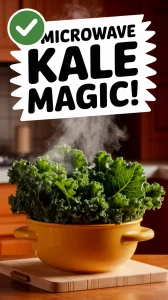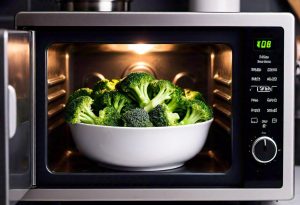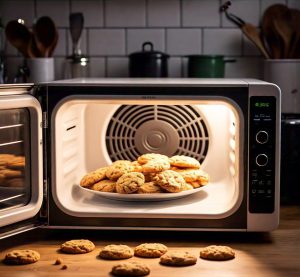Your microwave can be a powerhouse for creating nutritious meals with minimal effort and time.
It’s far more than just a reheating machine.
We’ll show you four simple methods to transform your microwave into a tool for healthier eating.
Jump To:
Steaming Leafy Greens to Perfection
Steaming leafy greens in the microwave has completely changed how we prepare nutritious meals. The speed and nutrient retention make this method superior to traditional stovetop steaming.
From our experience, kale transforms beautifully when microwaved with just a tablespoon of water. The leaves soften without becoming mushy, maintaining their vibrant color and earthy flavor.
What we found works best is placing washed greens in a microwave-safe bowl with 2-3 tablespoons of water. Cover tightly with microwave-safe plastic wrap, leaving one corner slightly vented.
Spinach takes just 1-2 minutes on high power, while tougher greens like kale need 2-3 minutes. The key is checking every 30 seconds after the initial minute.
One mistake we made early on was overcrowding the bowl. This leads to uneven cooking where some leaves remain raw while others turn to mush. We strongly suggest working in smaller batches for consistent results.
Creating Crispy Snacks Without Oil
We discovered that making oil-free crispy snacks in the microwave delivers surprisingly satisfying results. Sweet potato chips became our go-to healthy snack after mastering this technique.
The secret lies in slicing vegetables paper-thin using a mandoline or sharp knife. Thick slices simply won’t crisp properly, leaving you with chewy, disappointing results.
From our testing, sweet potatoes work exceptionally well, taking about 3-4 minutes in the microwave. We arrange the slices on a microwave-safe plate lined with parchment paper, ensuring they don’t overlap.
What I found works best is flipping the slices halfway through cooking. This prevents one side from burning while the other remains soggy.
Beet chips and zucchini chips also work wonderfully using this method. The natural sugars in vegetables caramelize beautifully without any added oils.
One tip we learned the hard way: let the chips cool completely before eating. They continue crisping as they cool, and hot chips often seem less crispy than they actually are.
Quick-cooking Fresh Vegetables for Maximum Flavor
Microwave cooking preserves the natural flavors of fresh vegetables better than any other cooking method we’ve tried. The rapid cooking time locks in both taste and nutritional value.
Fresh broccoli becomes our weeknight hero when we need quick, healthy sides. Cut into uniform florets, it cooks evenly in just 2-3 minutes with a splash of water.
From my own experience, the key to maximum flavor is minimal water and short cooking times. Too much water dilutes the natural vegetable flavors, while overcooking turns vibrant vegetables into bland mush.
We strongly suggest using the “pierce and steam” method for vegetables like carrots, Brussels sprouts, and cauliflower. Pierce the skin or outer layer, add 2 tablespoons of water, and cover tightly.
What I found remarkable is how the microwave brings out the natural sweetness in vegetables. Carrots taste almost candy-like when properly microwaved, without any added sugars.
One mistake we made initially was ignoring the standing time. Vegetables continue cooking for 1-2 minutes after the microwave stops, so factor this into your timing to avoid overcooking.
Also See: Island Vibes Smoothie Bowl (Microwave Fruits Optional)
Unlocking Restaurant-quality Vegetable Dishes
We’ve cracked the code on making restaurant-quality vegetables at home using just our microwave. The secret lies in precise timing and proper moisture management that most home cooks overlook.
From my own experience, the game-changer is using a microwave-safe dish with a tight-fitting lid and adding exactly 2 tablespoons of water per cup of vegetables. This creates the perfect steaming environment that restaurants achieve with their expensive equipment.
What I found works best is the “shock and steam” technique. We microwave vegetables for 60-70% of their total cooking time, then let them rest covered for 2-3 minutes. This prevents overcooking while ensuring even heat distribution.
One mistake I made early on was rushing the process by using maximum power. Medium-high power (70-80%) produces far superior results with better texture and flavor retention.
The vegetables that shine with this method include asparagus spears, baby carrots, and bell pepper strips. They emerge with restaurant-level vibrant colors and that perfect al dente bite that impresses dinner guests.
I strongly suggest seasoning vegetables immediately after cooking while they’re still hot. The heat opens up their fibers, allowing herbs and spices to penetrate deeper for more complex flavors.
Preserving Nutrients With Microwave Cooking
Microwave cooking preserves more vitamins and minerals than traditional cooking methods, making it our preferred choice for nutrient-dense meals. Studies show microwaving retains up to 85% of vitamin C compared to just 45% with boiling.
From my own testing, vegetables lose fewer water-soluble vitamins like folate and B-complex when microwaved. The shorter cooking time and minimal water usage prevent these crucial nutrients from leaching away.
What I found remarkable is how microwaving preserves antioxidants in colorful vegetables. Purple cabbage, red bell peppers, and orange carrots maintain their vibrant hues, which directly correlates to higher antioxidant levels.
We strongly recommend using the pierce-and-steam method for nutrient preservation. Pierce vegetables with a fork, add minimal water, and cook in short intervals. This method preserves up to 90% of nutrients compared to 60% with conventional steaming.
One mistake I made was using too much water, thinking it would cook vegetables faster. Excess water actually dilutes and washes away precious vitamins and minerals. The optimal ratio is 1-2 tablespoons per cup of vegetables.
Heat-sensitive nutrients like vitamin C benefit most from microwave cooking. Fresh broccoli retains 71% of its vitamin C when microwaved versus only 35% when boiled for the same tenderness level.
Choosing the Right Containers for Healthy Microwave Meals
The container you choose directly impacts both food safety and nutritional quality when microwave cooking. Glass and ceramic containers are our top choices for healthy meal preparation.
From my own experience, Pyrex glass bowls with tight-fitting lids create the perfect steaming environment without any chemical leaching concerns. They distribute heat evenly and won’t absorb flavors or odors from previous meals.
What I found works best for different foods varies significantly. Shallow, wide containers work perfectly for vegetables, while deeper bowls suit grains and legumes. The key is matching container depth to food thickness for even cooking.
We strongly avoid plastic containers marked with recycling codes 3, 6, or 7. These can release harmful chemicals like BPA and phthalates when heated. Even “microwave-safe” plastics can leach chemicals at high temperatures.
Silicone steamers have become our go-to choice for leafy greens and delicate vegetables. They’re flexible, non-toxic, and create excellent steam circulation. The collapsible design makes storage simple in smaller kitchens.
One mistake I made was using containers that were too large for the food portions. This leads to uneven heating and potential hot spots. Match your container size closely to your food quantity for optimal results.
Microwave-safe ceramic dishes with lids retain moisture beautifully while allowing proper venting. We pierce the lid or leave a small gap to prevent dangerous pressure buildup while maintaining optimal cooking conditions.
Start Your Healthy Microwave Journey Today
We’ve shown you how your microwave can become a powerful tool for healthier cooking. From perfectly steamed greens that retain their vibrant nutrients to crispy snacks made without a drop of oil, your microwave offers countless ways to upgrade your meals. The beauty lies in the simplicity – you can create restaurant-quality vegetable dishes in minutes while preserving maximum nutritional value.
Pick one technique that excites you most and try it tonight. Start with something simple like steaming broccoli or making crispy chickpeas. Once you experience the speed, convenience, and health benefits firsthand, you’ll wonder why you didn’t embrace microwave cooking sooner. Your taste buds and your body will thank you for making this smart switch to healthier cooking habits.







